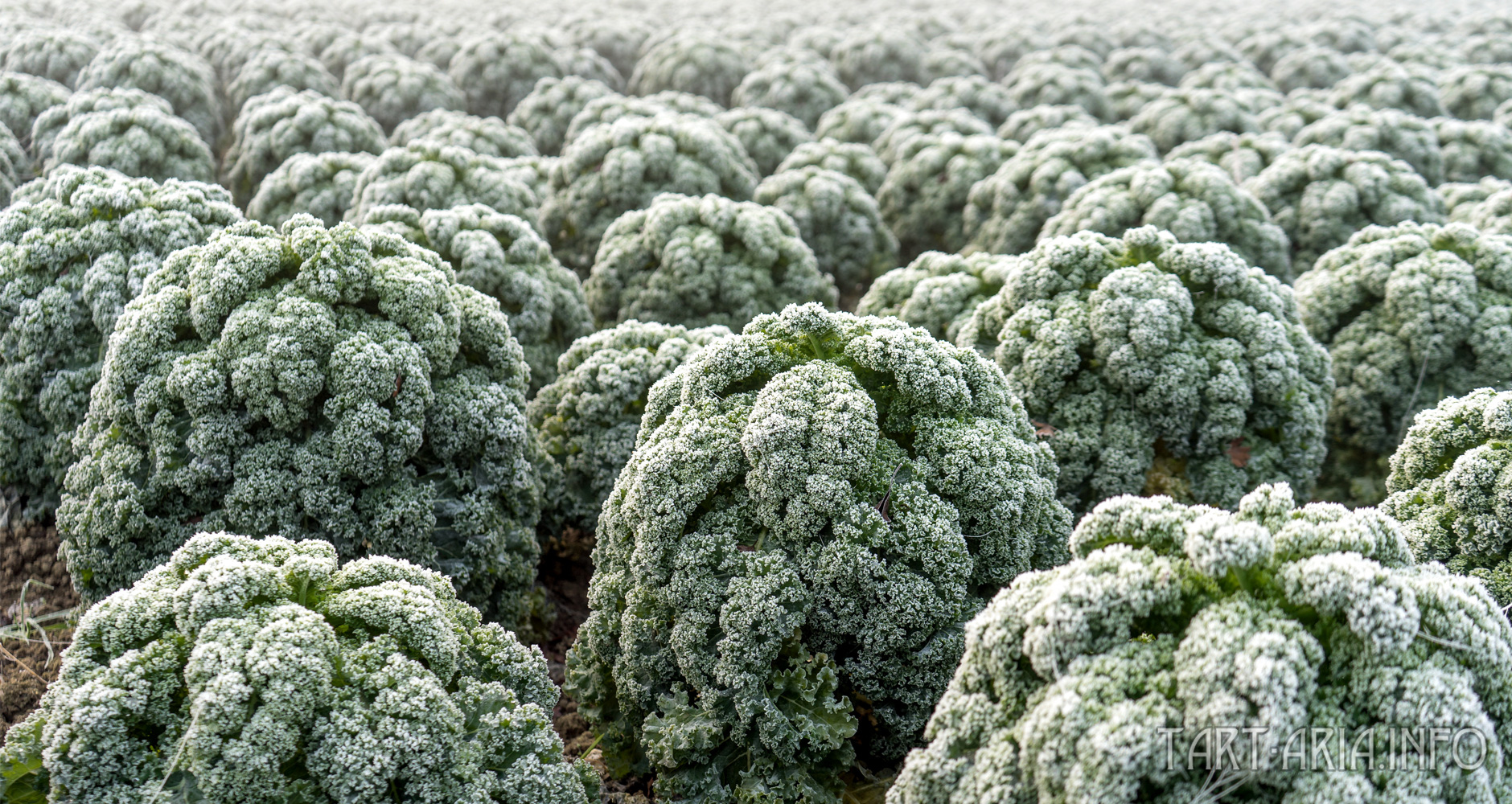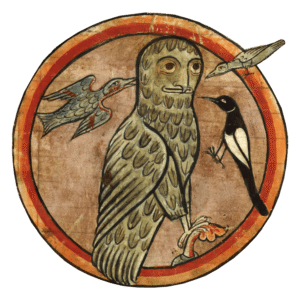If you google the phrase “The year without a summer”, many articles show up in the results. But if we start digging deeper into that it turns out the definition given above has been introduced recently. It is not used in climatology books, published even in the second half of the 20th century.
It was William Humphreys who first mentioned the troubled year of 1816 in 1920, connecting its disasters to the eruption of Mount Tambora (Indonesia) in April 1815. The fact became generally acknowledged as early as in 1979 when American oceanographer Henry Stommel and his wife Elizabeth published their article “The Year Without a Summer” in the Scientific American magazine.
Little Ice Age
In1982 after his vast research using historical documentation aimed to reconstruct the climate change of the last few centuries, a Soviet climatologist Evgenii Borisenkov published his book Climate and Human Activity. The book contained a long List of References, fifty sources concerning climate studies. But the year 1816 was mentioned only twice in that book, in the following extract:
“After 1560 very tough climatic conditions settled in Switzerland. There were cold winters and springs, cold and humid summers. Corn failures were reported in 1614, 1717, 1731 and 1785, vine harvest failures in 1588, 1628, 1692, 1698 and 1816. Such climate extremes influenced economy, civil and social life. From 1680 to 1718 cold summers with tremendous amount of precipitation were reported in France. There were heavy droughts in Europe from 1782 to 1785. The years between 1812 and 1821 and especially 1816 and 1817 were very cold and heavily humid. Cold winter was documented in 1657-58. Its average temperature on the territory from Denmark to Sweden was about 4° C lower then during the period 1931-1960. Such weather conditions resulted in freezing of straits to the east of Jutland”.
I.e. that was one of the cold periods starting in 1812. Such cold periods occurred before and after that year. A big number of climatologists use the term Little Ice Age.
Little Ice Age (LIA) is a period of global relative cooling extending from XIV to XIX centuries. The given period is the coldest in average annual temperatures within last 2 thousand years. Prior to the LIA was climatic optimum (approximately X-XIII centuries)which is the period of relatively warm and settled weather, mild winters and lack of heavy droughts. Source.
Several causes have been proposed:
- Orbital cycles;
- Diminishing of solar activity;
- Heightened volcanic activity;
- Changes in the ocean circulation;
- Reforestation or deforestation traced to population fluctuation in different parts of the world;
- Inherent variability of global climate.
And of no small importance is the fact that those causes arose after the Great Plague. Even before it as the Plague or the Great Mortality was itself the consequence of the beginning of global cataclysm, see the article “Catastrophe”. The diminishing of sunlight and heightened volcanic activity were mentioned there as well.
How do ocean currents affect climate?
Climate is dramatically affected by ocean currents. You can see it on the picture:
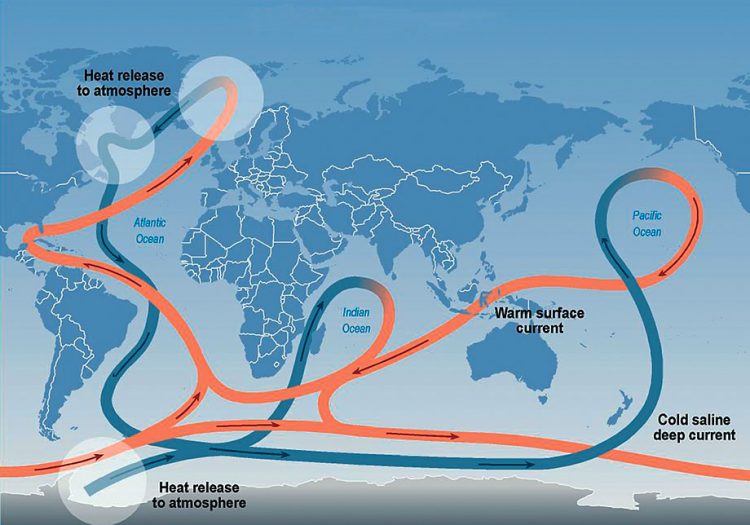
The global circulation of cold and warm currents. On the scheme the cold deep current is blue; the warm surface current is orange. There is also Antarctic Circumpolar Current but it isn’t shown here. The warm Atlantic ocean current is called the Gulf Stream. It flows along the coast of Western Europe to the Scandinavian Peninsula, Svalbard, the Barents Sea, and the Arctic Ocean. Here is how it affects the temperature:

These cities are situated approximately on the same parallel, but their climate differs a lot. And it’s not because of their continentality as Nikolaevsk-on-Amur is situated near the sea, even closer to the sea then Hamburg. What’s more, winters in Northwestern Europe (for example in England, Germany, Denmark, the Netherlands, and even southern Norway) are milder then winters in steppe areas of Crimea or Kuban, although these territories are further south. And that is thanks to the Gulf Stream. According to the scientists in case, it stops Europe will face the climatic catastrophe.
The explosion on the oil platform in the Gulf of Mexico on April 20, 2010 grabbed media headlines. An article with the title “The Gulf stream died. We are waiting for a new ice age?” says:
Life on the Earth just changed… the Gulf stream is dead. According to the latest satellite data, the Gulf stream no longer exists. The whole system of ocean currents in the North Atlantic is a key element of thermal regulation of the planet allowing Ireland and England to be free of ice and the Scandinavian countries to be less cold.
The system of thermohaline circulation that protected the world from the new Ice Age is now in some places dead and is dying in other areas.
In Germany for two months in a row (November and December of 2010) the permanent snow cover remained about 10 cm thick, something that hadn’t happened within many decades. Here the temperatures usually plunge to -20°C. This year there was no snowbreak typical for the onset of winter.
Dr. Gianluigi of Zangari, a theoretical physicist from the Institute in Frascati, Italy, was the first to announce that the Gulf stream had stalled. The scientist and a group of experts had been monitoring the situation in the Gulf of Mexico for several years. His research was published in a magazine article of June 12, 2010 and was based on CCAR satellite data, Colorado, NOAA, upon confirming with the US Navy. Later on the satellite map operational data were changed and the scientist was convinced that that was a “forge”.
Nowadays the topic is not discussed. It is reported that the Gulf stream is slowly diminishing, but it had been reported even before the oil spill in the Gulf of Mexico. On December 1, 2005 the British scientists announced that within the last 13 years the Gulf stream reduced by 30 percent that might cause a lapse of temperature. It is also reported that due to the temperature drop the weather became extreme having plunging temperatures, extreme heat, and droughts or downpours and gales causing destruction and floods. Global warming is considered to be a reason for the warm current weakening. Basically, having read several scientific articles, I understood that scientists are not sure about the nature of the Gulf stream and hope it won’t stall.
There are also warm and cold currents around the South Pole.
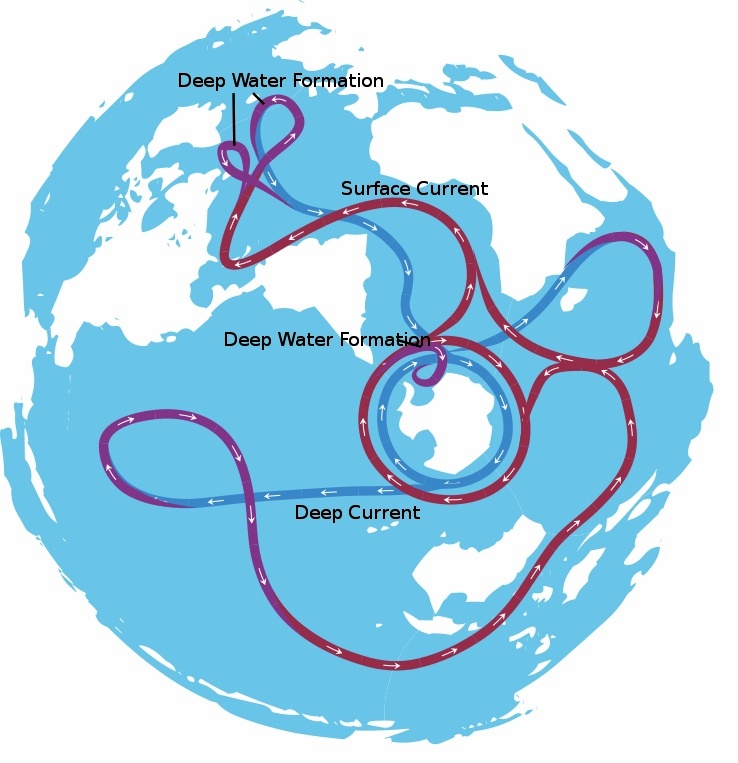
Moreover, the cold flow makes the inner circle and the warm flow is the outer circle. Perhaps, there was a time when the circumpolar flow existed around the North Pole as well. Only it was vice versa, the warm flow was forming the inner circle and the cold flow was the outer circle which allowed the residents of the northmost continent wearing antique clothing.
Was the thermal regulation of the planet manually controlled?
That is how the continent looked on Mercator's 1595 map.
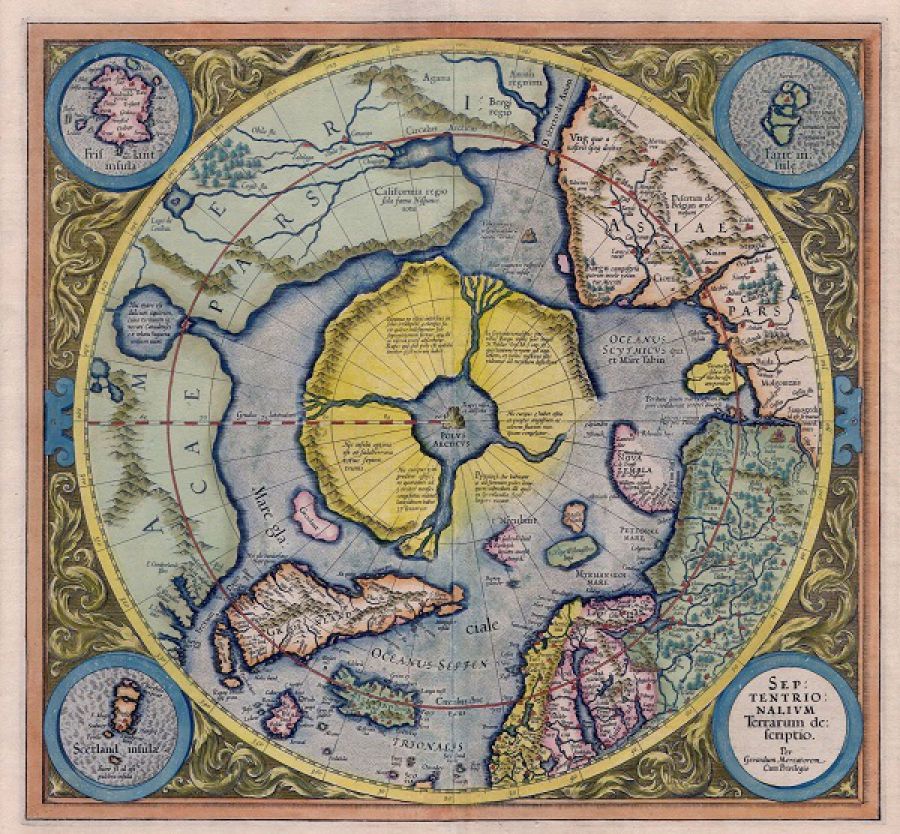
Its shape is surprisingly accurate for a nature-made object. Its side exposed to Eurasia looks destroyed and the islands near it might be its parts. They are named the New Lands:
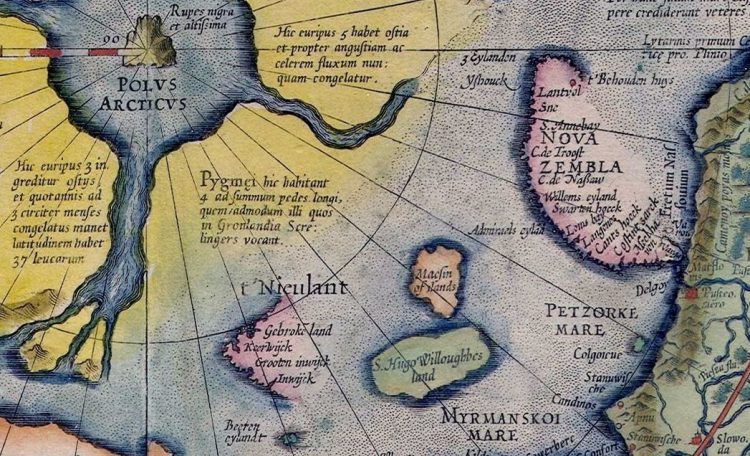
The biggest part of the land is called in Russian “Nova Zembla” (New Land), the smaller one is called “Nieulant”, which in Dutch means “New Land”. Most probably, it is Spitsbergen now. It is written there Gebroke land Keerwijck (Broken land or turning point in Dutch). There is a small island under it called “Beren Eylandt” (Bear’s island), still existing. The islands “Macsin of the island” and “S. Hudo Willoughbes” no longer exist. Unless it is Frantz Josef Land which is situated further north, i.e. it was still a part of the continent. We will not labor the point. Interesting is the fact that the northern continent had a shape of a full circle. Plus it had a slope towards the center and maybe it was even (following Mercator’s description). There was a huge water source in its center; again it was round, having a high mountain in its center. The continent was divided into 4 almost equal parts. It was divided with straits that started with 5 creeks making 20 creeks that also were entries of the continent. And there was no other way to come inside (taking into account that the place was surrounded by mountains). The water was flowing INSIDE the continent. It made a swirl in the center and went down. According to a Dutch source:
The map’s explanatory text says that an important part of the book "Invention" (Discovery) included the geographical description of the North Pole. Most likely, there was an unknown country, consisting of 4 large islands, and it was situated around the Polar point. Four large internal rivers connected the ocean with the internal sea where the big black rock emerged right in the Polar point. Black Rock (Rupes Nigra) was 33 nautical miles in circumference and was almost reaching the sky. The rock was magnetic which explains why all compasses point North.
Water flow made a big swirl or whirlpool around the rocky island where the water finally disappeared in the Earth’s abyss. Source.
You can find more information in my article “Hyperbore on Mercator’s map”. Perhaps, there was a pump inside of the continent providing water circulation of the global ocean. It sounds weird nowadays. And maybe Mercator or a person from whom Mercator took this information just made it all up. But it fits quite well with the present system of water circulation. Such circulation around the North Pole could be a reason for a mild favorable climate of the past: remember that light clothing or even naked bodies represented by antique sculptures together with high technology and high artistic buildings and household items. Now we can’t wear such clothing either it’s too hot or too cold. It demands really mild climate. Mammoths (id. elephants) lived In Siberia and in the arctic circle. They didn’t eat fir-needles and wouldn’t be able to dig up dry grass from under ice crust with their “hooves”. They need 300 kg of verdurous greenery every day.
“An elephant in the wild consumes 300 kg of leaves and grass containing a high percentage of water a day. In captivity elephants eat about 30 kg of dry forage, 10 kg of vegetables and 10 kg of bread. An elephant drinks 100-300 liters of water a day depending on the air temperature”. Source
And judging by the number of tusks found during last few centuries even in the Extreme North and the Arctic islands there were lots of mammoths there. When the Arctic died, perhaps because of a catastrophe, the planet pump was destroyed, water circulation of the planet changed and the Little Ice Age started. The Dutch say that even in 14th century there were hotheads who went to that barren but still existing continent. Few came back alive. But thanks to them we now know what we know. Maybe the continent was plunging and freezing slowly otherwise trips and exploration would be impossible. In that case, some other disaster occurred to mammoths frozen rapidly with undigested food in their stomachs. And maybe it happened much later. Or maybe the descriptions (and maps) remained from the time the continent was inhabited?
That is how Borisenko describes the beginning of the Little Ice Age in his book “Climate and Human Activity”:
“The transition to the Little Ice Age started between 1300 and 1450. The average temperature dropped 1.3-1.4°. In the mountains of Southern Europe the tree line lowered 200 meters which together with average laps rate of 0.6—0.7°/100 meters corresponded the observed temperature drop. The growing season became 3 weeks shorter.
The polar ice blocked up the costs of Greenland and Iceland. As a result the settlements of the Europeans were cut out of the Europe. During the extreme period of 1675-1704 (1695 is considered to be the most extreme) the cold polar water was prevalent near the Iceland and the Faeroes. As H. Lamb says, the ocean surface was 0.5° C colder then it is now. The unstableness of atmospheric processes increased, the cyclic activity intensified, the number of floods raised, etc. On the whole, the winter temperatures within the period of 1443-1700 were visibly lower then during the following 250 years. It should be noted that amid the cooling there were some warm periods like mild winters in England and other countries in 1665-1666 and 1718-1719.The Alpine glacier developed again and occupied the territories that had been deliberated during the climatic optimum. The spread of glacier was common for the Northern Hemisphere during the Little Ice Age. It impacted agriculture strongly. For example in some provinces of China almost all orange trees were winterkilled due to the winter frosts of 1654-1676. Crop failures were reported traced to the cold and humid summer weather conditions in Japan in 1782-1787, 1833-1839, 1866-1869.
The Little Ice Age was peaking in 1550-1700, and the climate varied most in late XIV- early XV and in XVI-XVII centuries. Glaciation of European mountains peaked in 1600. The second peak was in 1820 after a strong cooling of 1812-1817. Summers were humid and chilly and winters were frosty. In Switzerland within the warm period of 1525-1569 48 warm and 21 chilly summer months (June-August) were reported. And also there was a cold period between 1570 and 1600 with 26 warm and 44 cold summer months”.
The second period of the Little Ice Age in the early XIX century.
As discussed, the second peak of cooling within the Little Ice Age began in 1812, not in 1816 and it wasn’t connected to the Mount Tambora eruption of 1815. There was another reason for that. What was it? Many authentic history researchers have come to a conclusion that in early XIX century some catastrophe took place resulting in flooding of cities, fields, and forests with a thick layer of mud and dirt. There are several versions of this catastrophe, as it is not listed in the official sources. The fact that something terrible has happened in recent past may be proved by what we can see now: whelmed ground floors of old buildings, lack of fertile soil and ancient forests on vast territories of the planet.
Many books refer to the year 1816 as the year without a summer. But they all were written in late XX century. We will now enlarge on a book written by Canadian climatologists, issued in 1992 under the title: “The year without a summer? World climate in 1816”. The authors had done a great job examining and putting together the climate data of that period. And not only that. Using other authors’ books and weather stations’ reports, ship’s journals and other documents of the XIX century, containing information about weather, crops, corn and alimentary products pricing. They reached the conclusion that the extensive cooling had begun before the Mount Tambora erupted. In 1816 there was a regional temperature curve in eastern parts of Northern America, Western Europe, and China where temperatures fell whereas in the West of Northern America, Eastern Europe (i.e. in Russia) and Japan it rose.
“Although they are indirect evidences it seems that there was vast cooling before the Mount Tambora eruption. Apparently the massive aerosol injection into the atmosphere caused crossing of the temperature threshold in some parts of the globe (perhaps including blocking highs and monsoon destroying). Of course “the year without a summer” in 1816 is a local phenomenon. In the Northern Hemisphere, in western parts of Northern America, in eastern Europe and Japan apparently the temperatures were average or above average unlike remarkable cold typical for most of the eastern parts of Northern America, Western Europe and China. The interference of arctic air masses to South in some regions was compensated by the polar flow of tropic air in others”.
There is evidence in the book that the cooling began in 1812 and not in 1816:
“Comparison of data of weather stations on the territory of the Russian Empire as of 1812 (Kiev, Reval (Tallinn), Riga, Saint Petersburg (Leningrad), Vilnius, Voiri and Warsaw) shows that although the year on the whole was quite cold, October was a bit milder than during a long period. By estimate in mid October Napoleon’s Great Army started its stepback from Moscow. November was relatively chilly and December was freezing. The greater part of the badly hit army reached Vilnius in December; the temperature was about -20° C. In June the army transected the Neman on their way to Moscow (almost the same date when the Germans crossed the river to rich the Soviet Union in 1941). When they came on the territory of Russia officers and soldiers of the Great Army were well fed and warmly clad. In December when they reached Vilnius on their way back the rest of the soldiers were ragged and starving.
“More than that in 1812 it was much colder then in 1816 compared to the weather records of the Baltic weather stations in 1814, although there was no recorded eruption before 1812. Examination of grain crop statistics in Denmark, Finland, Norway and Sweden doesn’t show any considerable crop failures in 1816 or 1817. On the contrary, the year 1812 (the cold year) was remarkable for the poor harvest leading to local food shortage; partly due to the war-time situation (The Royal Navy embargo) it was difficult to obtain supplies from abroad. The mortality data in the above mentioned countries is also available. The mortality rate was relatively high in 1812 and/or 1813, but not in 1816-17.
Harvest and mortality data records in Russia are lacking. Hunger lists in Russia are clean in 1816. In 1817 the prices rose in several parts of the Empire.
Though the difference between the average temperatures of 1814 and 1816 during the period of April-September was negative on all weather stations, whereas the year 1812 was far colder then 1816. Besides, there were no signs of any poor harvests either in 1816 or in 1817, but in 1812 there was a food shortage resulting in local famines in Norway. Death toll for those countries was high in 1812 and 1813, not in 1816-17. In Russia in 1812 the corn harvests were poor near Moscow and in Siberia; in 1817 there was a small food shortage. As for 1816 neither famines nor deaths were reported. Grain export to England from north-western and northern Russia increased since 1816 to 1817”. Source “The year without a summer? : world climate in 1816”
Famine in Russia
Here’s what Wikipedia says about starvation in Russia:
“In 1842 the government averred that crop failures occurred every 6-7 years, lasting for 2 years. In mid-to-late XIX century the most severe were the famines traceable to poor harvests of 1873, 1880 and 1883”.
The year 1816 and the beginning of the century had no significant events. A Canadian source about the food shortage in Russia:
“Russia
There is no data on grain production either grain export-import, but there is some information about years of starvation and in some cases the years when the harvests were poor.
The most detailed list is provided by A. Kahan in his «Russian Economic History. The nineteenth century», 1968, pages 367-375. As for the early XIX century, Kahan states that grain crops were poor in 1812 near Moscow and in Siberia and in 1817 there was drought in chernozemic regions resulting in raise of pricing. Comparing to the data sheets of other years, people were not the hardest hit in 1817. Anyways in 1816 bread shortage or starvation is not reported. Neither Dando’s nor Robinson’s lists mention the food shortage in 1817. Sorokin (1975, page 179) says that in 1812 the government doled out 2.5 million rubles to buy and give out bread to those who starve in Moscow governorate and in 1813 6 million rubles were doled out for the same purpose in Kaluga and Smolensk governorate. In all probability the shortage was the result of the cold 1812. In 1816 bread shortage wasn’t mentioned.
In addition to what has been documented by English sources here is some information from Russian encyclopedias, published in Czarist period by the end of XIX century. The articles about famine in Russia and Europe are quite large and informative unlike the Great Soviet Encyclopedia. No author mentions the famine in Russia of 1816, 1817, although there is a piece of information about 1817 famine in Germany”. (The year without a summer? : world climate in 1816)
The Canadian climatologists’ book says that in 1816-1817 Russia exported grain via northwestern and northern Russian ports (Liepãja, Riga, Saint Petersburg and Arkhangelsk). The hypothesis was made that if Russia had had a grain shortage, it wouldn’t have exported it. On the other hand, in 1818 and 1819 the export was prohibited. The article “Famine as a social and economical phenomenon” of K.K. Arseniev’s New Encyclopedic Dictionary of 1913 contains the following information:
“Even in lean years Russia has plenty of bread and grain export rarely stops. There have to be other reasons except for the crop failure to make people starve”.
In XX century several books on famine in Russia have issued abroad:
•Dando, W.A. 1981. «Man-made famines: some geographical insights from an exploratory study of a millennium of Russian famine. In: Famine: Its Causes, Effects and Management.»
•Kahan, A. 1968. «Natural calamities and their effect upon food supply in Russia»
•Kazmer, D.R. and V. Kazmer. 1977. «Russian Economic History, A Guide to Information Sources”
•Robbins, R.G., Jr. 1979. «Famine in Russia. In: The Modern Encyclopedia of Russian and Soviet History», Volume II.
The article “Famine as a social disaster” (Brockhaus and Efrone Encyclopedic Dictionary) affirms the following:
“Never has the whole territory of Russia been hit by famine. As early as in 1819 the Committee of Ministers announced that “taking into account Russia’s vastness and variety of its climate zones and soils it never has had and won’t have a countrywide hunger, no matter how poor the harvest is. In some areas plenty of bread would remain”. And that is why “with active bread trading, transporting ease and wise farseeing there can be no hunger or even bread shortage anywhere”. Source.
The conclusion is that the famine in Russia might be man-caused.
A medallion in memory of 1816 famine in Germany
With the exception of few pictures showing the disaster of 1816, there are commemorative medals produced by Johann Thomas Stettner (1785-1872), the Bavarian graver, on the famine and dearness 1816 and 1817 in Germany.
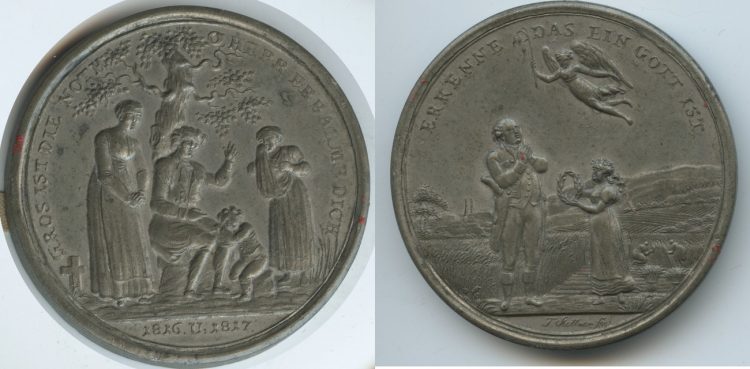
The same graver manufactured 4 medals on the 1816 disasters and 4 medals on the favorable events of 1817 with explanatory text on their reverse and a medal with main alimentary products prices as of 1816 on the obverse and 1771 on the reverse.
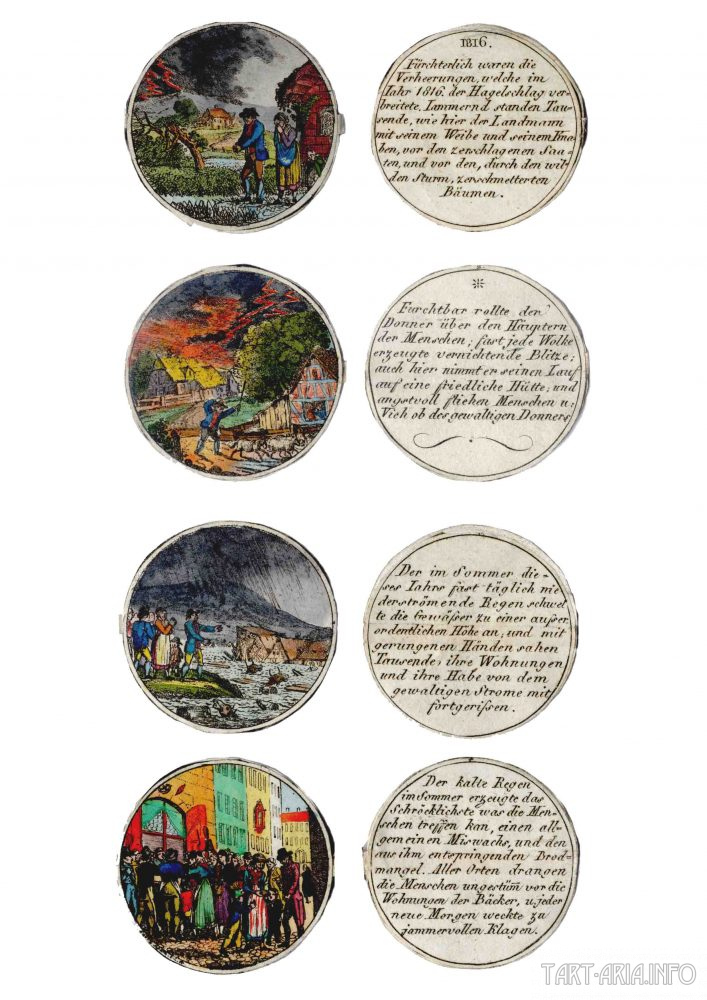
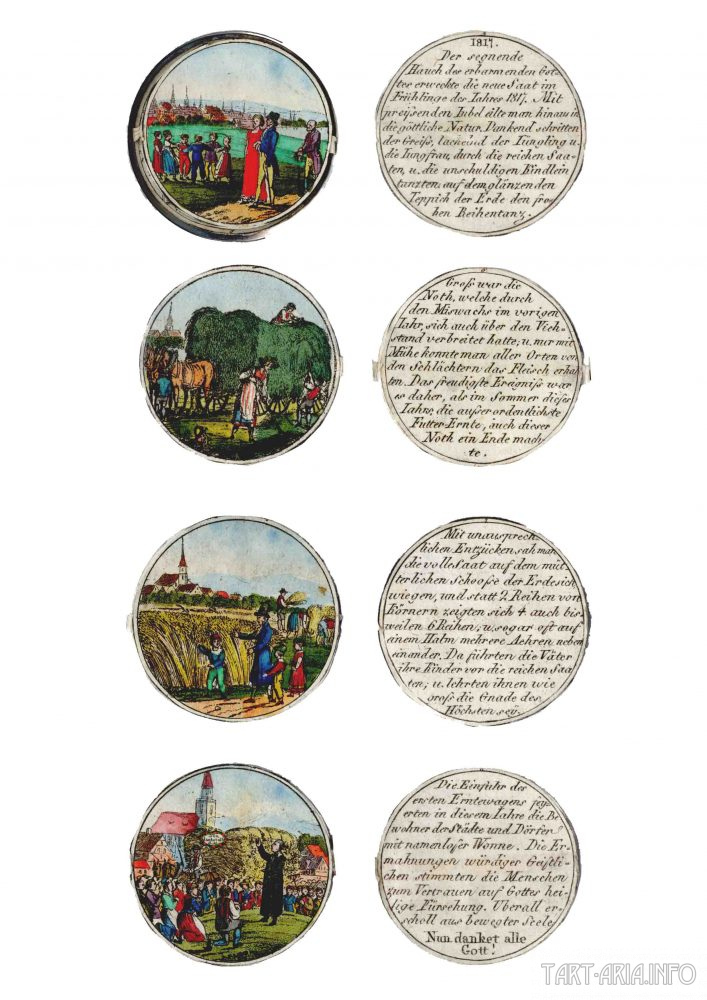
The text in brief: In 1816 heavy thunderstorms with their loud claps of thunder and vivid flashes of lightning were common. Hail showers got the crops and a severe storm ruined houses and trees. Due to steady rains, there was poor grain harvest and people had been queuing outside bakeries to buy some bread since early morning.
In 1817 the grain crop was copious, fodder was plentiful. The peculiarity was that there were several wheat heads on one culm. This had been documented before. The article “Catastrophe”: “In 1547 the small wheat in different shapes and types was harvested in Flanders, three miles away from Ghent. Some with connivent wheat heads, some with separated wheat heads, with 4, 8, 12, up to 15 wheat heads on a culm”.
These medals might be the only significant evidence of anomalous 1816 weather conditions besides the textual documents I have mentioned before. There are also some sources that report unusually colorful sunsets in some places taking as examples pictures of other time periods.
Translator: Карине Пироженко








